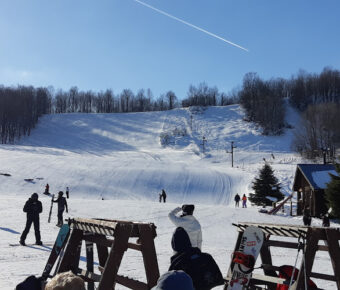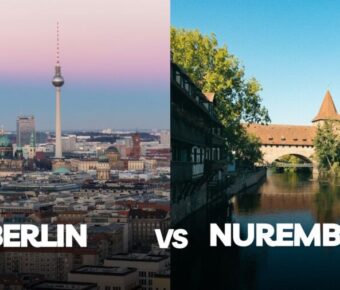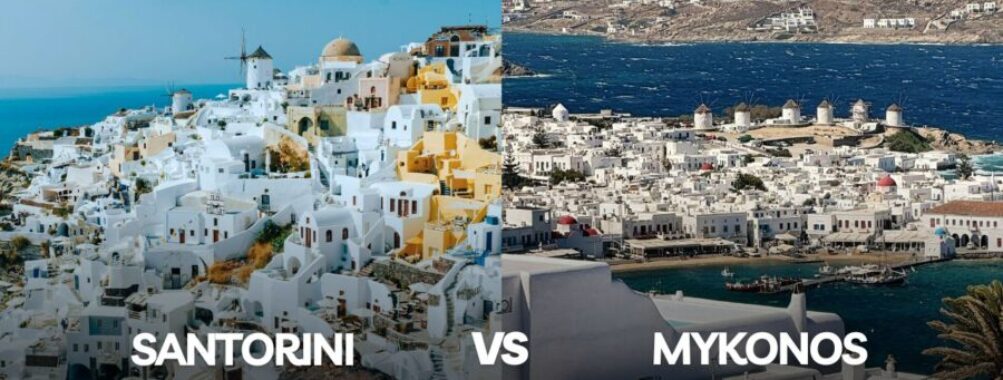
Santorini vs Mykonos: Which Iconic Greek Paradise Best Fits Your Travel Style in 2025
Dreaming of a Greek island getaway? Choosing between Santorini and Mykonos can be tricky since each island offers a distinct flavor of Mediterranean magic. Santorini is perfect for romantic couples seeking stunning caldera views and sunset-watching, while Mykonos draws party-lovers and beach enthusiasts with its vibrant nightlife and golden shores.
These two gems of the Cyclades islands attract millions of visitors yearly, and each has carved out its special place in Greek tourism. Santorini wows with its whitewashed buildings perched on volcanic cliffs, while Mykonos charms with its iconic windmills and maze-like streets filled with boutiques and cafes.
Many travelers are torn between these popular destinations when planning their Greek adventure. The good news?
There’s no wrong choice – it all depends on what kind of vacation experience you’re after. Whether you seek romance, relaxation, or revelry, both islands deliver unforgettable Mediterranean memories.
Contents
- Geographical Overview
- Island Topography
- Climate and Weather Patterns
- Cultural Insights
- History and Heritage
- Architectural Highlights
- Art and Museums
- Accommodations and Stay
- Luxury Options
- Boutique Hotels
- Affordability and Choices
- Beaches and Nature
- Beach Comparisons
- Outdoor Activities
- Natural Escapes
- Dining and Cuisine
- Local Eateries
- Fine Dining
- Food Specialties
- Entertainment and Nightlife
- Nightlife Hotspots
- Local Festivities
- Relaxation and Wellness
- Transportation and Accessibility
- Getting There and Away
- Island Connectivity
- Public Transport
- Activities and Experiences
- Sports and Recreation
- Unique Island Experiences
- Day Trips and Excursions
- Choosing Your Island
- Pros and Cons
- Decision Factors
- Frequently Asked Questions
- What are the key differences in the travel experience between Santorini and Mykonos?
- Which island is better suited for a family vacation, Santorini or Mykonos?
- How do the costs of visiting Santorini compare to those of Mykonos?
- Regarding nightlife, which is the better destination, Santorini or Mykonos?
- Considering weather conditions, is Santorini warmer than Mykonos?
- Which island offers the most diverse activities among Santorini, Mykonos, and Crete?
- More Travel Guides
Geographical Overview
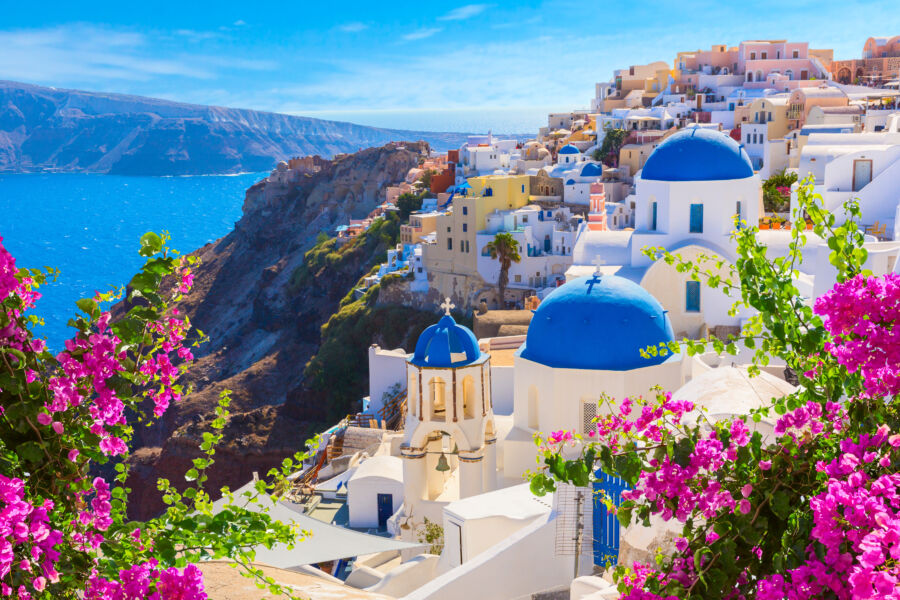
Santorini and Mykonos stand out in the Aegean Sea, which has remarkably different landscapes shaped by their distinct geological histories. Each island offers unique geographical features that create vastly different vacation experiences.
Island Topography
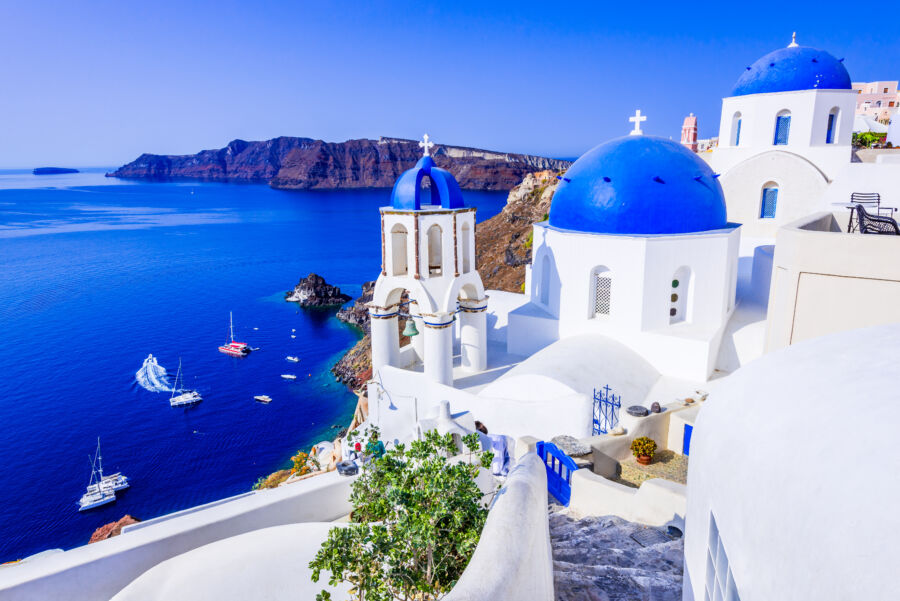
Santorini’s dramatic landscape comes from its volcanic origins. The island forms a crescent shape around a massive caldera, resulting from one of history’s most significant volcanic eruptions. Cliffs rise 300 meters above the sea, creating stunning viewpoints across the caldera.
The main towns of Fira and Oia perch on these clifftops, offering panoramic views of the volcano and neighboring islands. Black and red volcanic beaches dot the eastern coastline.
Mykonos has a gentler landscape with rolling hills and flat areas. Its granite terrain creates a more traditional Greek island setting. The island’s coastline features numerous sandy beaches and small coves.
Climate and Weather Patterns
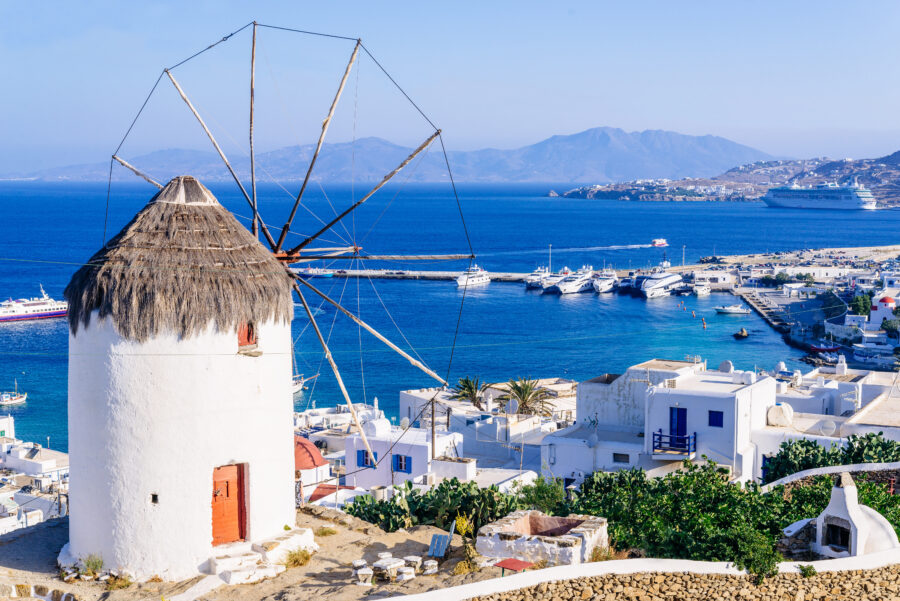
Both islands enjoy a typical Mediterranean climate with long, dry summers and mild winters. In peak season between June and September, temperatures range from 25-30°C (77-86°F).
Mykonos lives up to its nickname “Island of the Winds” with strong north winds called meltemi. These winds welcome cooling during hot summer days but can make beach time challenging.
Santorini experiences less wind impact due to its caldera walls, which provide natural shelter. The island experiences slightly warmer temperatures and lower rainfall than Mykonos throughout the year.
On both islands, beach days are possible from May through October. Spring and fall bring pleasant temperatures ideal for sightseeing and outdoor activities.
Cultural Insights

Mykonos and Santorini showcase their rich Greek heritage through distinct architectural styles, historical sites, and artistic traditions that reflect their unique island identities.
History and Heritage
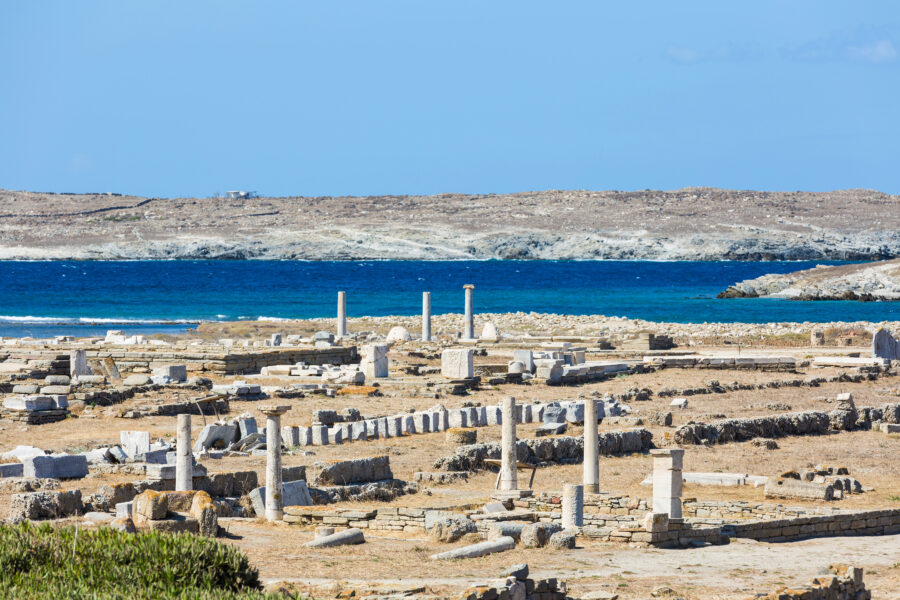
The ancient island of Delos, just a short boat ride from Mykonos, stands as one of Greece’s most significant archaeological sites. This UNESCO World Heritage site was the mythical birthplace of Apollo and Artemis.
Santorini’s past tells a different story, shaped by the massive volcanic eruption around 1600 BCE. The event created the island’s dramatic caldera and preserved the ancient Minoan settlement of Akrotiri – often called the “Pompeii of the Aegean.”
Mykonos grew as a trading port, with its iconic windmills as reminders of its 16th-century maritime commerce. The island’s traditional lifestyle is still visible in its local festivals and customs.
Architectural Highlights

Santorini’s villages feature unique cave houses carved into volcanic cliffs. The whitewashed buildings of Oia and Fira cascade down the caldera, creating the iconic postcard views.
Blue-domed churches dot both islands, but Santorini’s are built in a distinct style influenced by the need to withstand earthquakes. The medieval village of Pyrgos offers excellent examples of traditional Cycladic fortress architecture.
Mykonos shows off classic Cycladic design with its cubic houses, narrow streets, and wooden balconies painted in bright blues. The famous Little Venice quarter displays unique architecture influenced by medieval Italian traders.
Art and Museums
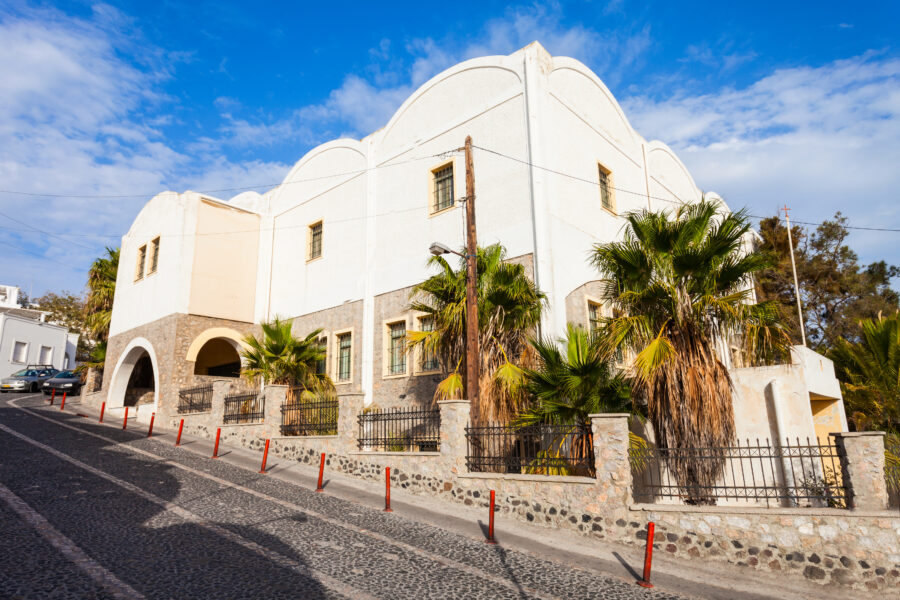
The Archaeological Museum of Mykonos houses artifacts from nearby Delos, including ancient pottery and sculptures. The Aegean Maritime Museum tells stories of the island’s seafaring history.
Santorini’s Museum of Prehistoric Thera displays fabulous finds from Akrotiri, including well-preserved frescoes and pottery. Local art galleries in Oia showcase modern Greek artists inspired by the island’s stunning landscapes.
Both islands maintain traditional craft workshops where visitors can watch artisans create ceramics and textiles using age-old techniques. The Museum of Ancient Tools in Santorini highlights the island’s agricultural and winemaking heritage.
See Related: Top Luxury Resorts in Greece: Unforgettable Mediterranean Escapes Await
Accommodations and Stay

Santorini and Mykonos offer amazing places to rest your head, from clifftop suites to beachfront villas. Each island offers distinct styles and price ranges to cater to different travelers.
Luxury Options
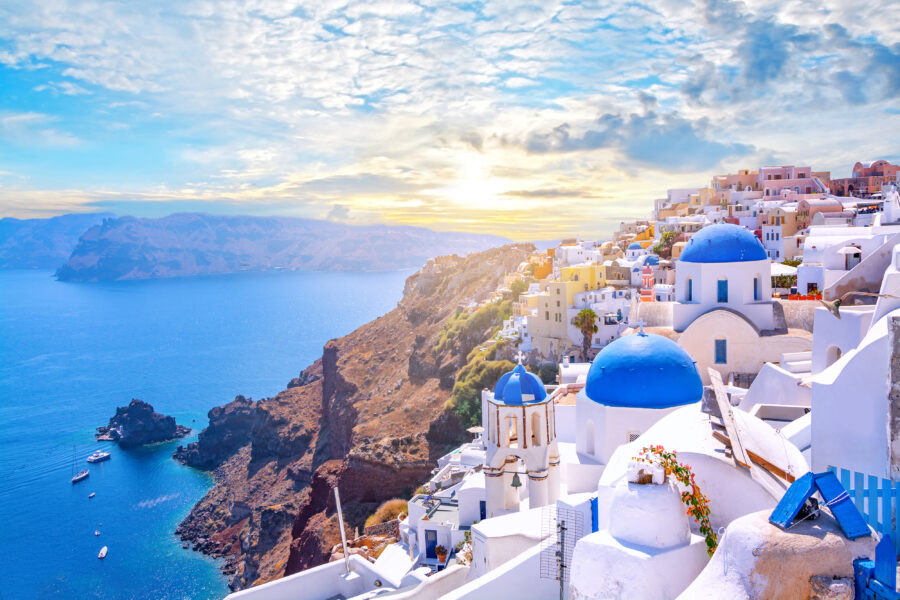
Santorini’s luxury hotels focus on caldera views and private infinity pools. Many high-end properties sit along the western edge in Oia and Imerovigli, built into the volcanic cliffs. These spots often include butler service and private terraces perfect for sunset watching.
Mykonos matches its brand of luxury. The island’s 5-star resorts blend Cycladic architecture with modern amenities. Most luxury stays center around Ornos Beach and Psarou Beach, offering direct beach access and top-tier service.
[Book your dream vacation] on either island starts at $500 per night during peak season.Boutique Hotels

Santorini excels in intimate boutique properties. Cave-style rooms carved into the cliffs create unique sleeping spaces—many feature local art and handcrafted furniture that showcase Greek design.
Mykonos boutique hotels lean toward a more contemporary style. Small properties in Mykonos Town mix traditional white-washed walls with stylish modern touches.
These mid-range options typically cost between $200 and $ 400 per night.
Affordability and Choices
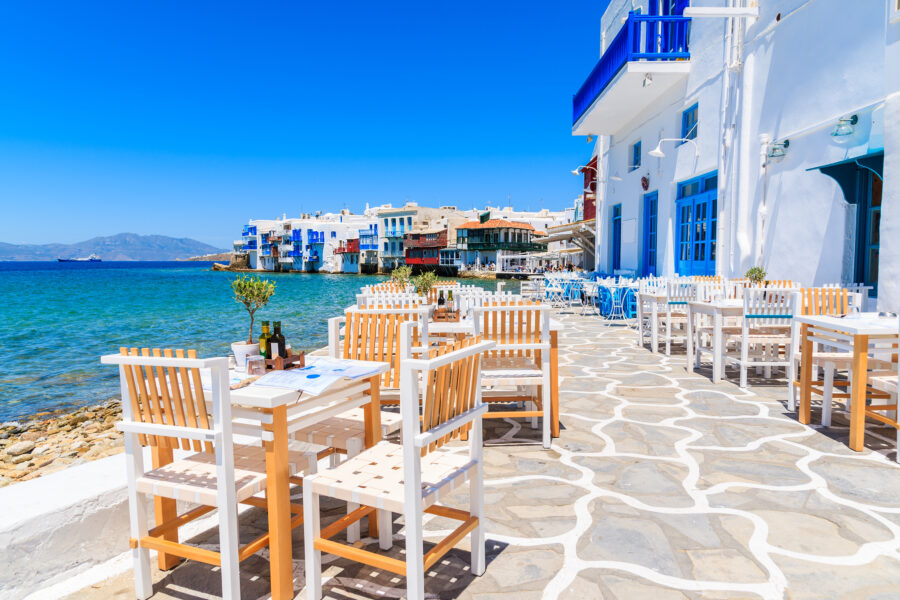
Budget-conscious travelers find better deals in Mykonos. The island has more small family-run hotels and guesthouses, especially away from the main tourist areas.
Santorini’s limited space means fewer affordable options. Simple studios exist in villages like Karterados and Megalochori, offering basic comforts at lower prices.
Both islands see prices jump 50-100% during July and August. Booking rooms in spring or fall saves money while still enjoying great weather.
Some family-friendly hotels include kids’ pools and connecting rooms. These properties tend to cluster in less party-focused areas of both islands.
Beaches and Nature
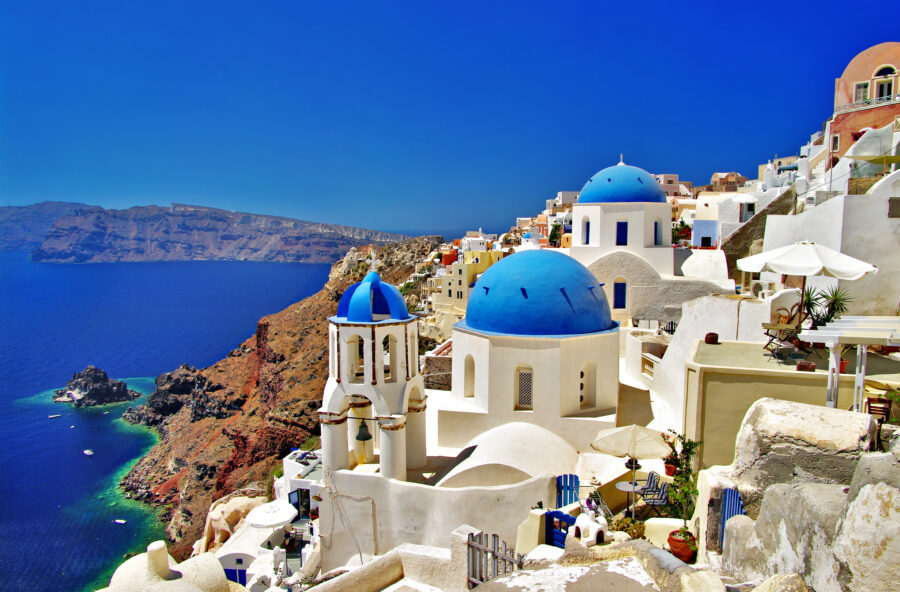
Both islands offer distinct coastal experiences with their unique landscapes and natural features. Santorini showcases dramatic volcanic beaches, while Mykonos boasts pristine golden sand beaches perfect for sunbathing and water sports.
Beach Comparisons
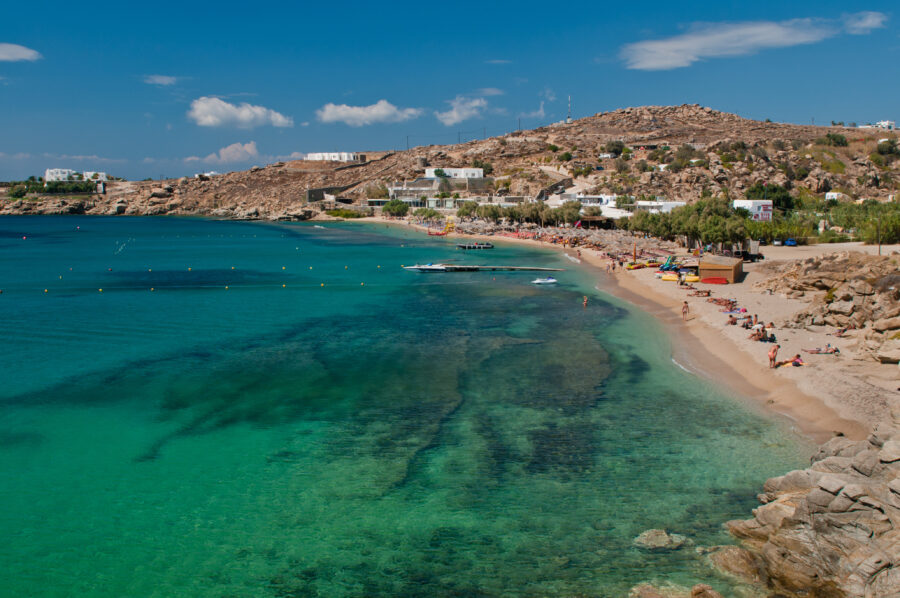
Santorini’s beaches stand out because of their volcanic origins. Red Beach dazzles visitors with its rust-colored cliffs and dark red sand, while Kamari Beach features striking black sand and pebbles against cliffs.
Mykonos shines with its golden sandy beaches. Paradise Beach draws party-loving crowds with its crystal-clear waters and beach clubs. Ornos Beach offers a more family-friendly setting with calm waters and excellent water sports facilities.
The water temperature stays warmer in Mykonos from May through October. Due to the deeper seas around the caldera, Santorini’s beaches tend to have rougher waves and calmer waters.
Outdoor Activities
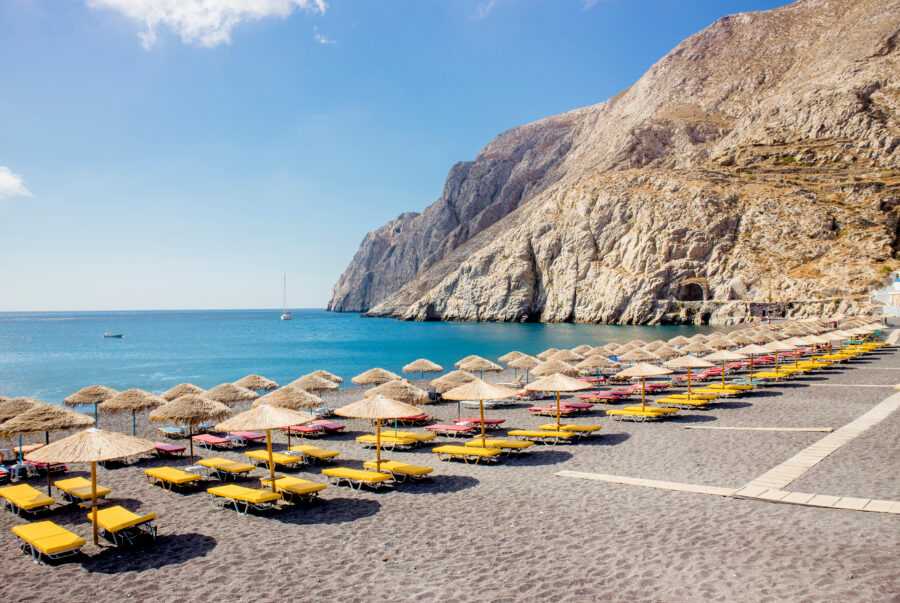
Santorini excels in hiking opportunities. The trail from Fira to Oia offers breathtaking caldera views and takes about 3-4 hours to complete.
Mykonos features excellent conditions for water sports. Most organized beaches allow visitors to try windsurfing, jet skiing, and parasailing.
Both islands offer amazing snorkeling spots. Santorini’s underwater volcanic formations create unique marine habitats, while Mykonos has clearer waters, which makes it better for spotting colorful fish.
Natural Escapes

Santorini’s volcanic landscape creates stunning natural attractions. The caldera cliffs rise 300 meters above sea level, offering remarkable sunset viewing spots.
The island’s volcanic history shaped unique rock formations and caves. Many visitors explore these geological wonders through guided tours.
Mykonos features a more traditional Mediterranean landscape. The island’s interior reveals hidden valleys, small lakes, and conventional farms.
The famous Mykonos windmills stand on a hill overlooking the sea. These 16th-century structures serve as both a natural viewpoint and a historic landmark.
Dining and Cuisine
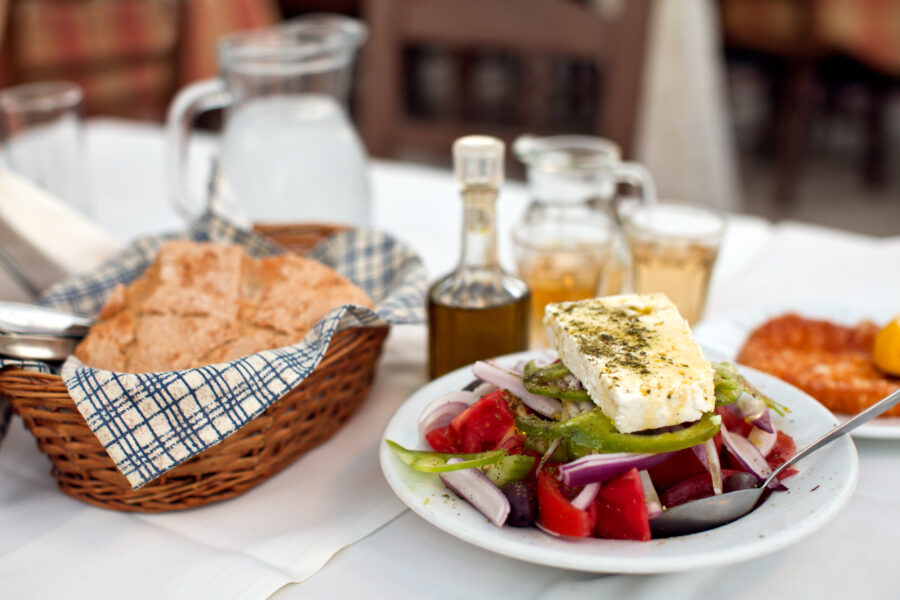
Mykonos and Santorini offer amazing food experiences that highlight Greek flavors differently. The dining scenes blend local traditions with modern culinary innovation.
Local Eateries
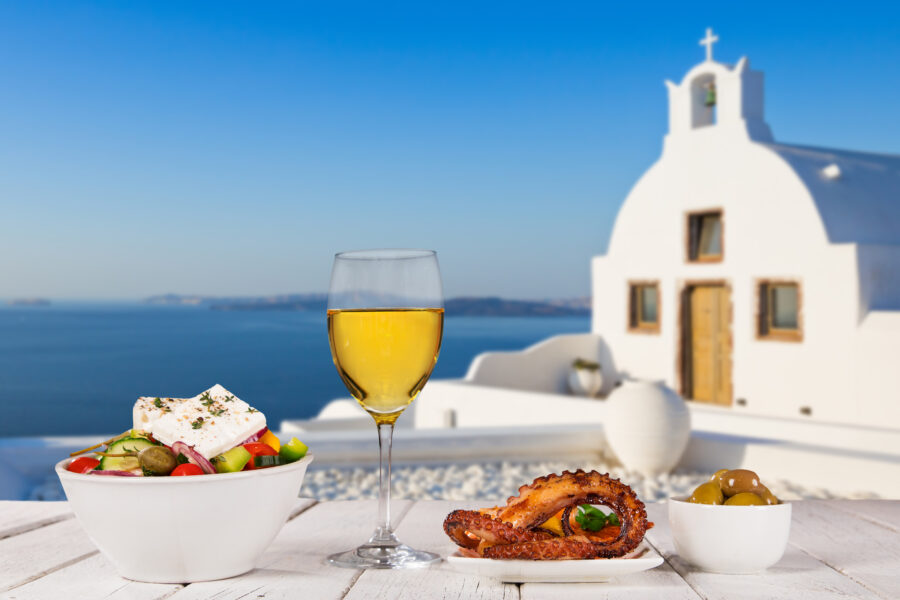
Mykonos shines with its seaside tavernas serving fresh-caught fish and traditional Greek dishes. Small family-run spots in Chora offer authentic moussaka and souvlaki at reasonable prices.
Santorini’s casual restaurants use the island’s volcanic soil-grown ingredients extensively. Cozy tavernas tucked into cliffside villages serve simple but tasty local specialties.
Many beachfront spots in Mykonos let you dig your toes in the sand while eating grilled octopus and Greek salads. The atmosphere stays relaxed, and prices tend to be moderate.
Fine Dining
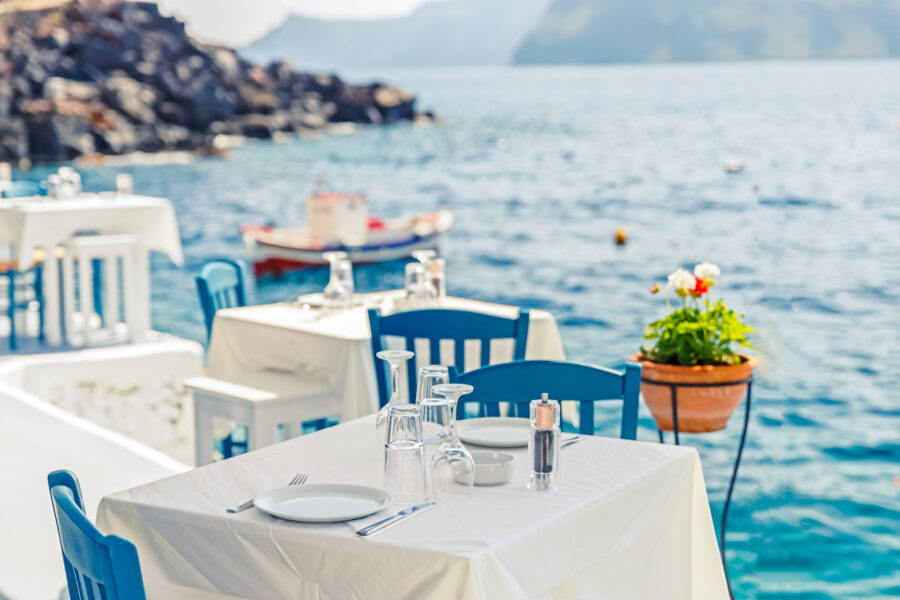
Mykonos leads in upscale dining with its collection of sophisticated restaurants. Many spots offer stunning sea views alongside creative Mediterranean cuisine. The island attracts celebrity chefs who put modern spins on Greek classics.
Santorini focuses more on romantic dining experiences. Cliffside restaurants in Oia and Fira provide sunset views that enhance the meal. The portions tend to be smaller but more artfully presented.
Both islands feature wine-pairing menus that showcase Greek varieties. Make reservations well ahead for the best tables during peak season.
Food Specialties
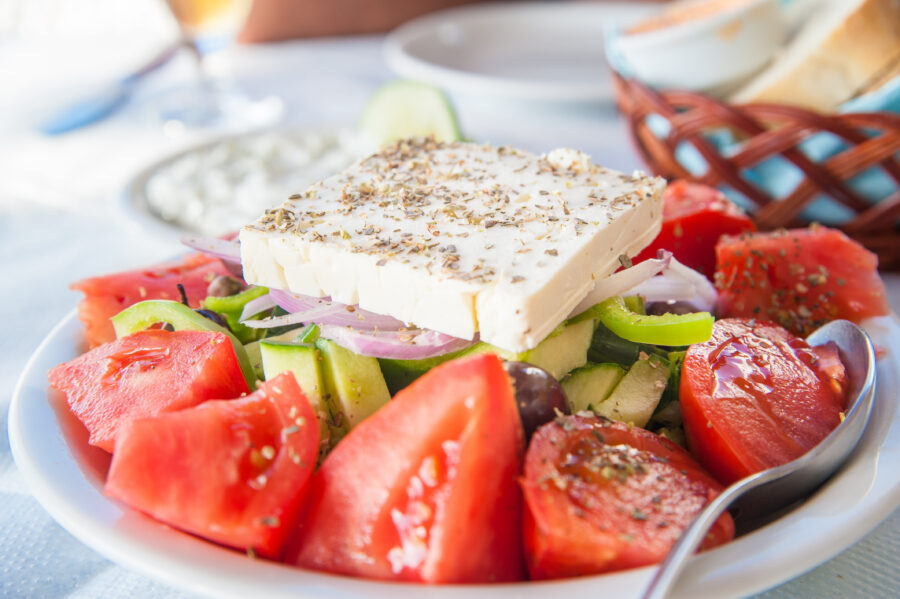
Mykonos is known for its kopanisti – a spicy cheese spread unique to the island. The fresh seafood stands out, especially the grilled fish and calamari caught daily by local fishermen.
Santorini’s volcanic soil produces distinct flavors. Must-try local dishes include:
- White eggplant
- Cherry tomatoes
- Fava bean puree
- Chloro cheese
- White wine made from Assyrtiko grapes
Each island approaches Greek favorites like moussaka and baklava differently. The different growing conditions and local traditions create unique taste experiences.
See Related: Most Famous Villas in Greece for Exclusive Aegean Hideaways
Entertainment and Nightlife
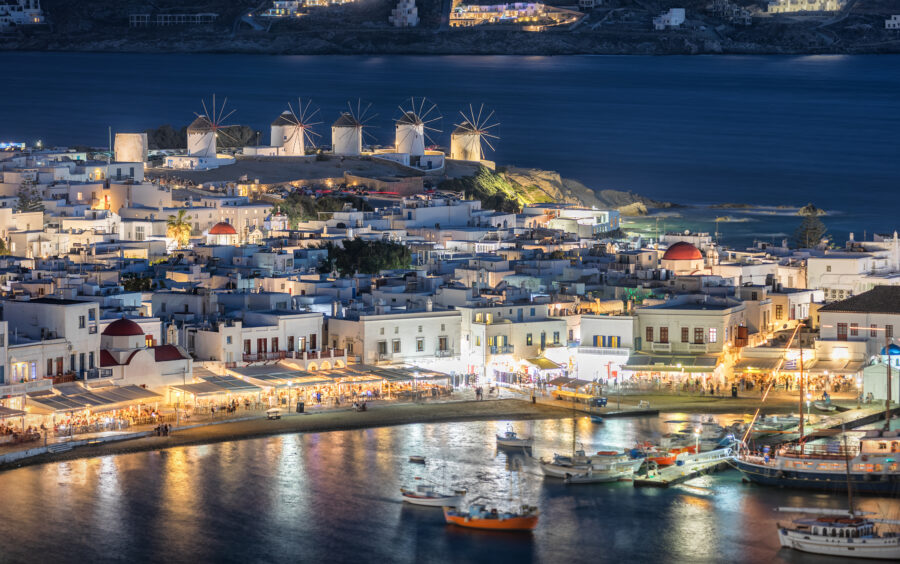
Mykonos and Santorini offer distinct after-dark experiences, from wild beach parties to peaceful sunset views. Each island caters to different entertainment tastes, making finding your perfect evening vibe easy.
Nightlife Hotspots

Mykonos stands as Greece’s party capital with world-famous clubs and beach bars. Paradise Beach and Super Paradise Beach come alive with dancing from afternoon till sunrise. The iconic Scorpios beach club attracts celebrities and party-goers with its mix of music and Mediterranean atmosphere.
Santorini’s nightlife centers on Fira, where small bars and cocktail lounges dot the cliffside streets. The vibe stays more laid-back than Mykonos, perfect for those seeking drinks with a view. Many venues offer live Greek music and local wine tastings.
Little Venice in Mykonos transforms into a bustling hub of bars and restaurants at night. Its waterfront location makes it ideal for watching the sunset while sipping cocktails.
Local Festivities

Both islands celebrate traditional Greek festivals throughout the summer. Mykonos hosts the Harvest Festival in September, featuring local wine, dance, and music performances.
Santorini’s festivals often revolve around religious celebrations, the most notable being the Ifestia Festival. This August event recreates the volcanic eruption that shaped the island with impressive fireworks.
Street musicians and performers add life to the narrow alleyways of both islands during peak season. You’ll find impromptu bouzouki performances in tavernas and public squares.
Relaxation and Wellness
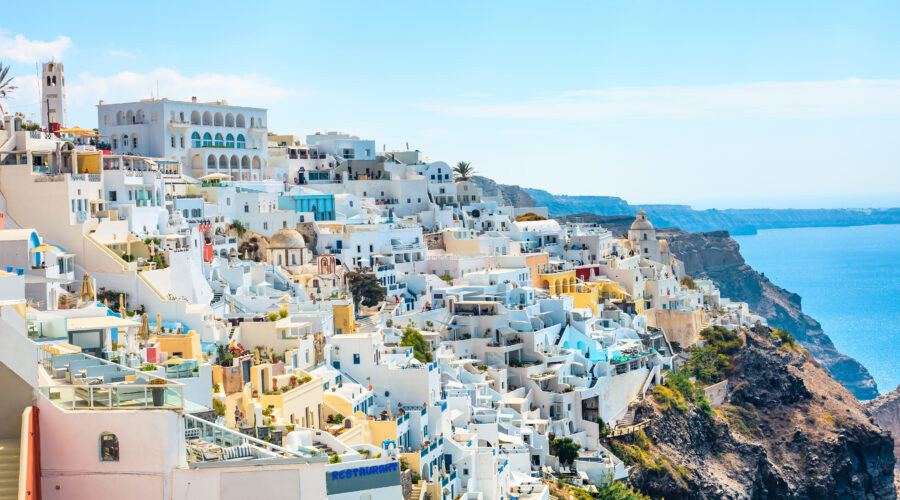
Santorini excels at peaceful evening activities. Many hotels offer sunset yoga sessions on private terraces, and the hot springs near the volcano provide natural spa experiences.
Mykonos balances its party reputation with luxury spa resorts. Several five-star properties feature treatment rooms overlooking the Aegean Sea. Wellness centers combine traditional Greek healing practices with modern techniques.
Both islands have open-air cinemas showing movies under the stars. Santorini’s Kamari Cinema sits against a mountain backdrop, while Mykonos’ Cine Manto operates in a garden setting.
Transportation and Accessibility
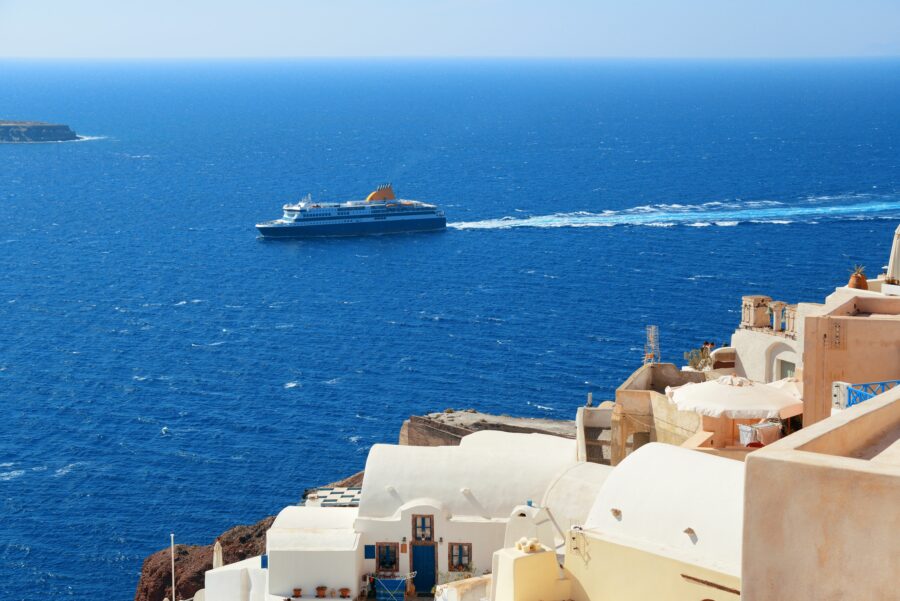
Both Santorini and Mykonos offer different ways to get around and explore. Each island has its unique transport system and challenges for visitors to consider.
Getting There and Away
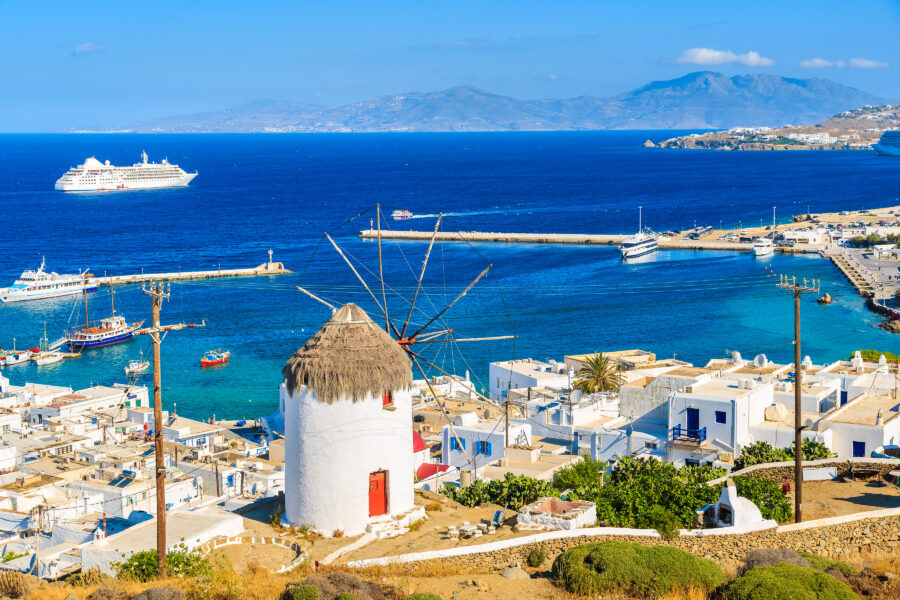
Santorini and Mykonos welcome travelers by air and sea. Both islands have airports with daily flights from Athens that take about 45 minutes. The peak season runs from June to September, when flight prices climb higher.
Taking a ferry from Athens is a popular choice. Fast ferries reach Mykonos in 2.5 hours, while Santorini takes 4-5 hours.
The ferry schedules change with the seasons. Summer brings more frequent trips, but winter sees limited service.
Island Connectivity
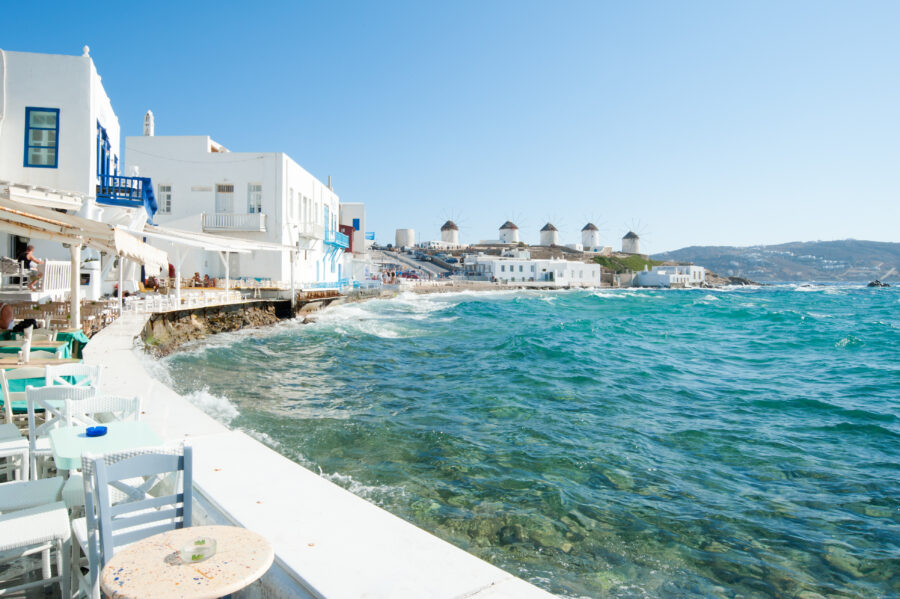
Mykonos town is perfect for walking. The old town’s narrow streets are car-free and easy to explore on foot.
Santorini’s towns spread across clifftops make walking more challenging. The steep paths between villages can be tough in the summer heat.
Both islands require transport to reach their beaches. Mykonos’s beaches are far from town, while Santorini’s best spots require a drive or boat ride.
Public Transport

Santorini’s bus network has more routes than Mykonos’s. In peak season, buses connect major towns and beaches every 30-60 minutes.
Mykonos buses focus on beach routes. Service becomes less frequent outside the summer months.
Transport options on both islands:
- Local buses
- Taxis (limited numbers)
- Rental cars and ATVs
- Private transfers
- Water taxis to beaches
The bus is cheap but often crowded. Taxis charge fixed rates between popular spots.
Activities and Experiences
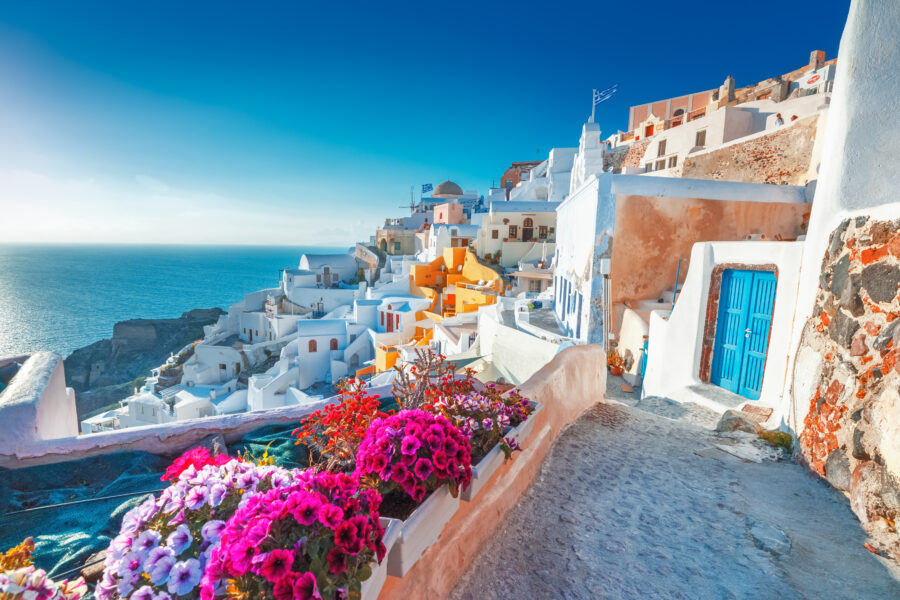
Both islands offer amazing activities that cater to different types of travelers. Santorini focuses on cultural experiences and natural wonders, while Mykonos shines with its vibrant beach life and water activities.
Sports and Recreation
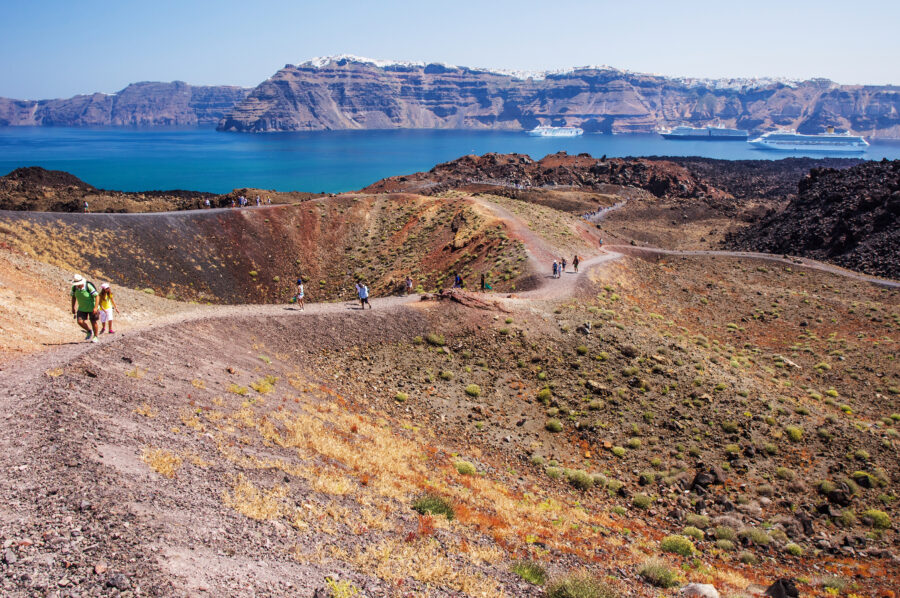
Mykonos stands out for water sports enthusiasts. The strong winds at Ftelia Beach make it perfect for windsurfing and kiteboarding. Kalafatis Beach offers jet skiing, wakeboarding, and parasailing opportunities.
Santorini’s volcanic landscape creates excellent hiking paths. The trail from Fira to Oia gives stunning views of the caldera, and rock climbing spots dot the cliffs near Kamari Beach.
Both islands offer great snorkeling and diving spots. Mykonos’ waters around Paradise Beach are more transparent, while Santorini’s underwater volcanic formations near Perissa Beach attract marine life.
Unique Island Experiences
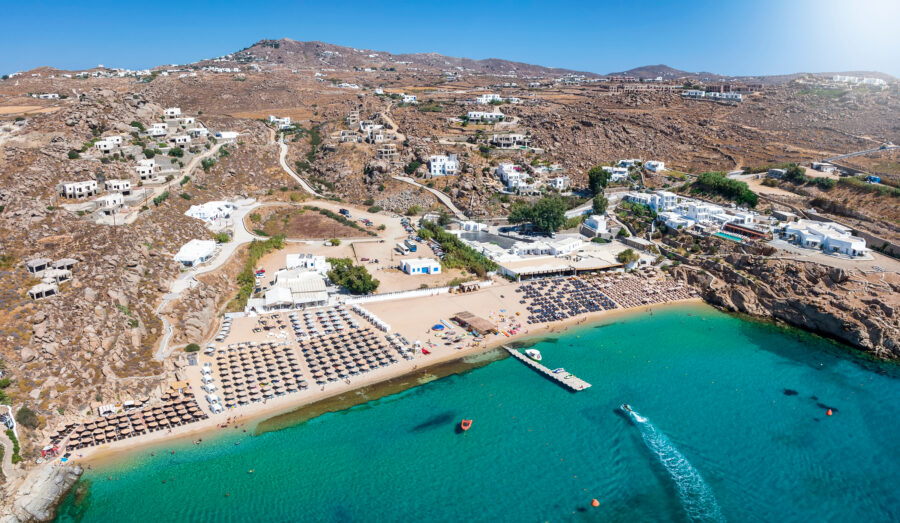
Book tours and activities to explore Santorini’s 16 wineries. Many offer tastings with sunset views over the caldera. The volcanic soil creates unique wine flavors found nowhere else in Greece.
Mykonos is famous for its beach parties—Paradise and Super Paradise beaches host world-renowned DJs from June through September.
Santorini’s traditional villages like Megalochori and Pyrgos offer cooking classes and pottery workshops. Learn to make Greek dishes or craft ceramics using ancient techniques.
Day Trips and Excursions
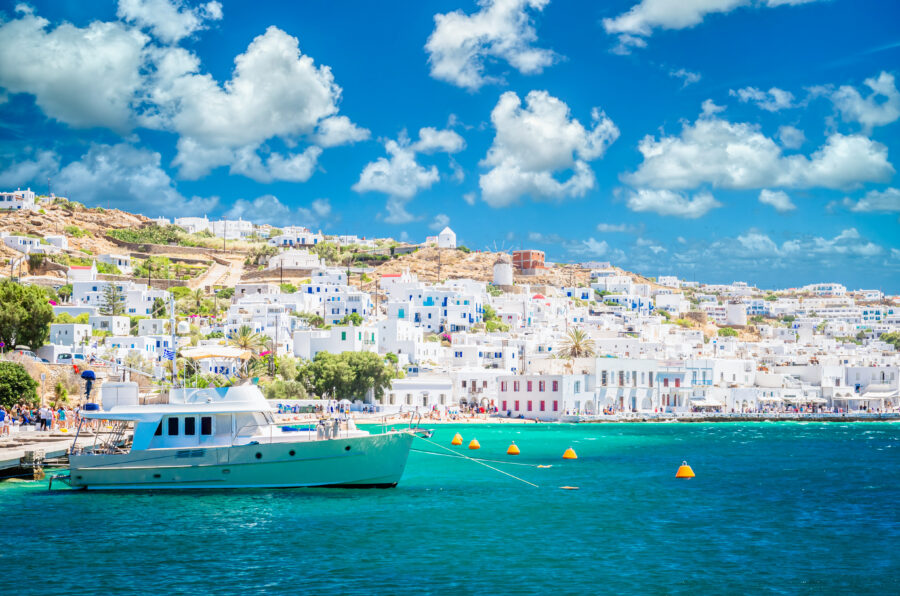
Sailing trips around Santorini’s caldera show off the red and white beaches. Many boats stop at the hot springs near the volcano for swimming.
From Mykonos, boats run daily to Delos Island, an important archaeological site. The ruins include ancient temples, theaters, and the famous Lion Terrace.
Both islands offer sunset cruises. Santorini’s trips usually include dinner and wine while viewing the famous Oia sunset. Mykonos cruises often include stops at secluded beaches and snorkeling spots.
Traditional fishing trips let visitors catch their dinner. Local fishermen teach ancient Mediterranean fishing methods that are still used today.
Choosing Your Island
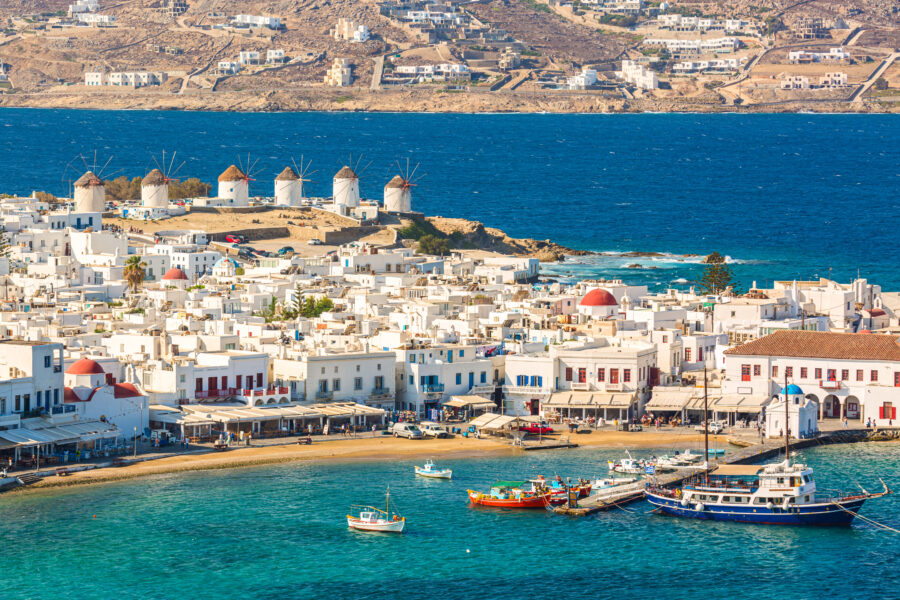
Picking between Mykonos and Santorini comes down to what type of Greek vacation you want. These islands offer very different experiences that match different travel styles and preferences.
Pros and Cons
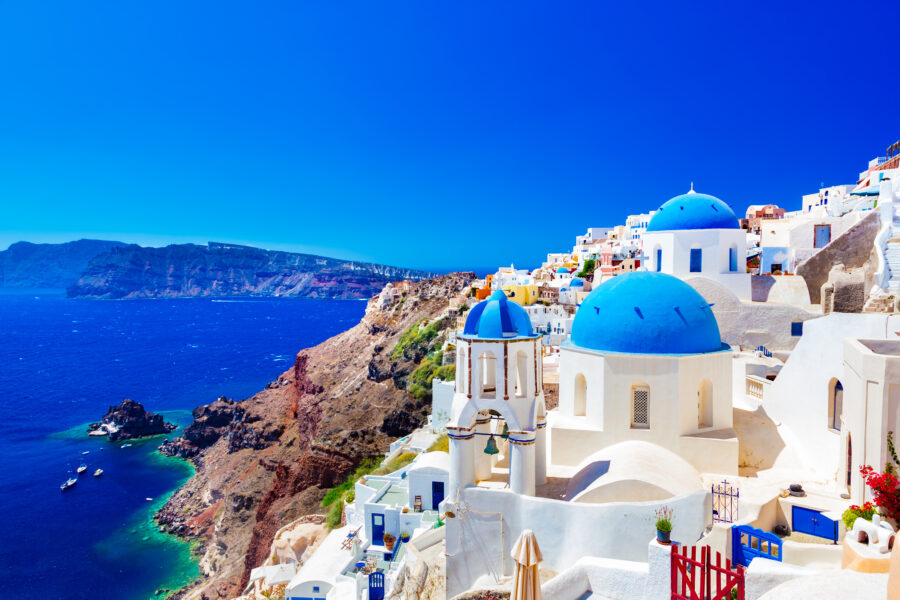
Santorini shines with its stunning caldera views and romantic atmosphere. The whitewashed buildings perched on cliffs create perfect sunset spots for couples.
Mykonos brings vibrant energy with its world-famous beach clubs and nightlife scene. The island draws a diverse crowd looking for fun and socializing.
Families prefer Santorini’s calmer pace and educational activities like volcano tours. The island has more kid-friendly hotels and restaurants.
Party-seekers and younger travelers gravitate toward Mykonos for its legendary clubs and beach parties. The LGBTQ+ community especially loves the welcoming atmosphere.
Decision Factors
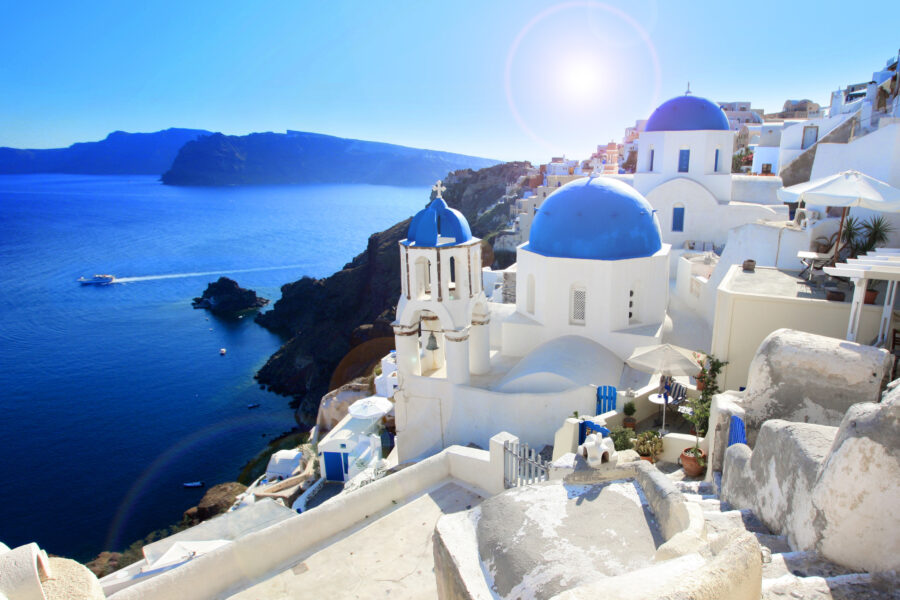
Key considerations for choosing:
Budget: Santorini’s luxury hotels cost more than similar options in Mykonos
Season: Mykonos gets very crowded in peak summer months
Activities:
- Santorini: Wine tasting, photography, historic sites
- Mykonos: Beach clubs, water sports, shopping
Best fits for each island:
- Santorini: Honeymooners, seniors, history buffs
- Mykonos: Party crowds, beach lovers, social butterflies
If time allows, consider visiting both islands. They’re only a few hours apart by ferry, making it easy to experience the unique charm of each destination.
See Related: Data-Driven Strategies to Optimize Your Greece Vacation (And Save Up to 60%)
Frequently Asked Questions
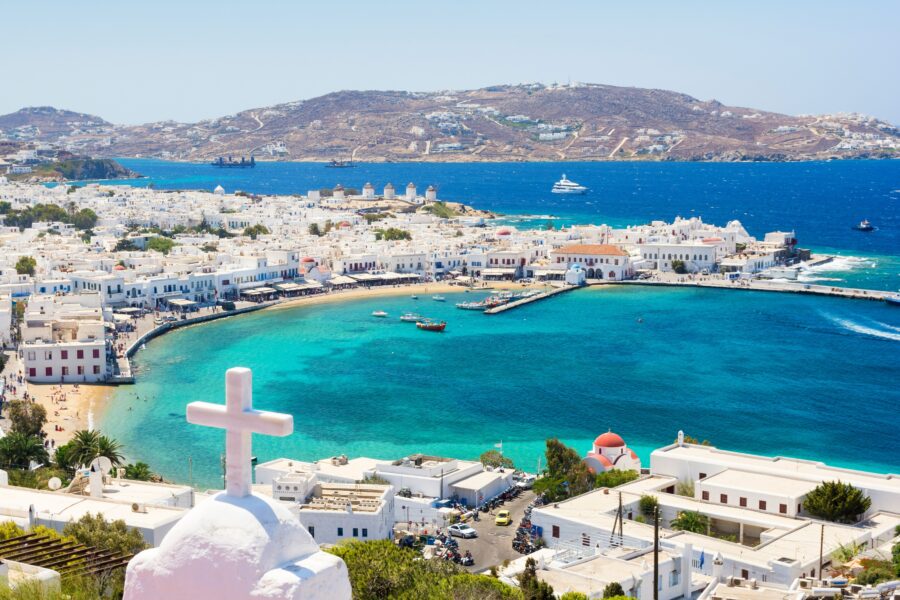
Many travelers want specific details about these popular Greek islands before booking their trips. These answers cover key differences in experiences, costs, and activities to help plan the perfect vacation.
What are the key differences in the travel experience between Santorini and Mykonos?
Santorini focuses on romance and relaxation with its famous caldera views and sunset spots. The island’s white-washed buildings cascade down volcanic cliffs, creating perfect photo opportunities.
Mykonos offers a livelier atmosphere with beautiful beaches and bustling streets. The island features iconic windmills, maze-like streets, and a vibrant shopping scene.
Which island is better suited for a family vacation, Santorini or Mykonos?
Santorini works better for families due to its calmer atmosphere and educational opportunities. Kids can explore ancient ruins and learn about volcanic history.
The island offers more family-friendly accommodations and restaurants. Many hotels feature pools and spacious rooms perfect for families.
How do the costs of visiting Santorini compare to those of Mykonos?
Both islands rank among Greece’s most expensive destinations. Hotels in prime locations on Santorini’s caldera cost 20-30% more than comparable Mykonos properties.
Food and activities cost slightly less in Mykonos. Beach clubs and luxury shopping tend to drive up costs on both islands.
Regarding nightlife, which is the better destination, Santorini or Mykonos?
Mykonos wins for nightlife with world-famous beach parties and clubs. The island attracts top DJs and stays active until sunrise during peak season.
Santorini offers more low-key evening entertainment. Most venues focus on sunset cocktails and romantic dinners rather than dancing.
Considering weather conditions, is Santorini warmer than Mykonos?
Both islands enjoy similar Mediterranean climates. Santorini stays slightly warmer in spring and fall, with temperatures about 2-3 degrees higher than Mykonos.
Mykonos experiences stronger winds, especially in the summer months. These winds, called meltemi, can affect beach activities and boat trips.
Which island offers the most diverse activities among Santorini, Mykonos, and Crete?
Due to its large size, Crete offers the most varied activities. The island features ancient ruins, hiking trails, water sports, and traditional villages.
Santorini and Mykonos focus on specific experiences. Santorini excels in wine tours and volcano excursions, while Mykonos stands out for beaches and water sports.
